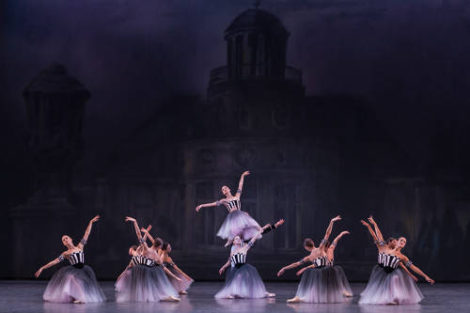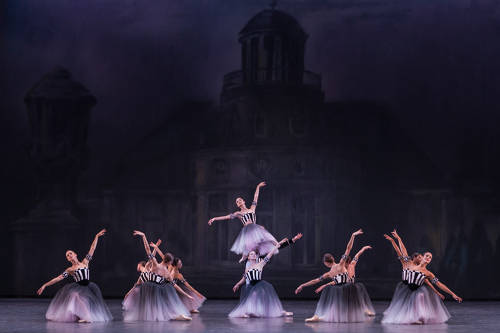9 November 2016, Palais Garnier, Paris
This all Balanchine program, which consisted of Mozartiana, Brahms-Schönberg Quartet and Violin Concerto, was staged in honour of Violette Verdy (1933-2016) who directed the Paris Opera Ballet between 1977 and 1980. I recall too that Mme Verdy coached Australian Ballet dancers during the directorship of Maina Gielgud and, of course, Verdy was a ballerina of international standing with a strong heritage of performing Balanchine. She died in February 2016. Earlier performances of this program also included Balanchine’s Sonatine, created for Verdy and Jean-Pierre Bonnefous in 1975, although by the time I got to see the program, Sonatine (for reasons unknown to me) had been dropped.
I have to admit to being slightly disappointed with Mozartiana. I have wonderful memories of it as performed by New York City Ballet where I loved the pride and the dignity that accompanied the dancing, and where the four young dancers who are included in the cast (in New York always from the School of American Ballet) seemed to be the recipients of a great tradition. While there was nothing amiss with the dancing by the Paris Opera Ballet cast I saw, including the young performers from the Paris Opera Ballet School, the work looked like nothing more than a pretty ballet to me. I did especially enjoy, however, the folk overtones in the choreography, and the performance by the second male lead, Fabien Revillion. Mozartiana is a new addition this season to the repertoire of the Paris Opera Ballet so it will be interesting to see how it develops on this company.
On the other hand, Brahms-Schönberg Quartet, which I had not seen before, and Violin Concerto were a huge pleasure to watch. In part it was seeing them together that gave such pleasure as they embody two quite different aspects of Balanchine’s choreographic approach.
Brahms-Schönberg Quartet, also a new addition to the repertoire of Paris Opera Ballet but originally made in 1966, had startling yet quite beautiful, newly created designs by Karl Lagerfeld. For the ladies, the classical long tutu was maintained but the designs on the bodices were black and white geometric patterns, as were the designs on the jackets and vests worn by the men. Choreographically, the style was clearly classical with groupings occasionally reminding me of those in Les Sylphides, especially in the third movement. There were some very lyrical, swooning lifts in the second movement, in which the colour scheme was pink and black, and some strong male dancing throughout. The final movement, however, came as a shock, albeit a pleasant and probably very Balanchinian one. The ladies continued to dance in pointe shoes but the men were in boots and the movement was in a rousing Hungarian peasant style.
The Stravinsky Violin Concerto, on the other hand, was one of Balanchine’s black and white ballets and showed him in his ‘show pony’ style where dancers bounced through every movement with individuality, even when strong unified movement was required (and given).

For me, the standout dancer in this work, and in fact in the entire program, was Hugo Marchand who partnered Amandine Albisson in the ‘Aria 1’ section. His own dancing showed great technical skills and his partnering displayed beautiful interaction with Albisson. I also loved his proud carriage of the body and particularly the way his body occupied the space around it—a very unusual quality possessed by very few.
Violin Concerto was given a remarkable performance and, while I’m not sure whether I was imagining this or not, I kept hearing brass instruments situated outside the orchestra pit. Surround sound? But wherever the brass instruments were, the sound from the orchestra of the Opéra national de Paris conducted by Kevin Rhodes was spectacular.
Michelle Potter, 10 November 2016
Featured image: Artists of the Paris Opera Ballet in Brahms-Schönberg Quartet, 2016. Photo: © Sébastien Mathé/Opéra national de Paris

For my Australian and New Zealand readers, sadly Hannah O’Neill was not performing the night I was there.
